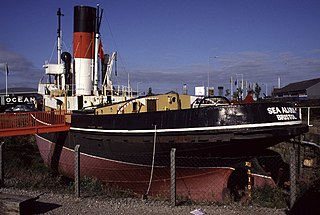Allied Shipbuilders Ltd is a privately held shipbuilding and ship repairing company established in Canada in 1948.

Henry Robb, Limited, known colloquially as Robbs, was a Scottish shipbuilding company based at Leith Docks in Edinburgh. Robbs was notable for building small-to-medium sized vessels, particularly tugs and dredgers.

Blackwall Yard is a small body of water that used to be a shipyard on the River Thames in Blackwall, engaged in ship building and later ship repairs for over 350 years. The yard closed in 1987.

A net laying ship, also known as a net layer, net tender, gate ship or boom defence vessel was a type of naval auxiliary ship.

The Ville-class harbour tugboats are a class of tugboats employed by the Royal Canadian Navy.

The Glen-class tug is a class of naval tugboat operated by the Royal Canadian Navy. Constructed in Canada, the class entered service between 1975 and 1977. The five vessels that comprise the class are split between the two major naval bases of the Royal Canadian Navy. The Royal Canadian Navy operated a fleet of tugboats during the Second World War which were also named the Glen class. The vessels of the current Glen class are each named after one of the vessels of the earlier class.
Kvaerner Govan Ltd (KGL), located at Govan in Glasgow on the River Clyde, was a shipyard subsidiary formed in 1988 when the Norwegian group Kværner Industrier purchased the Govan Shipbuilders division of the nationalised British Shipbuilders corporation. Prior to the Govan Shipyard's nationalisation in 1977, as a result of the Aircraft and Shipbuilding Industries Act, it had been operated by Govan Shipbuilders Ltd, which emerged from the collapse of the previous Upper Clyde Shipbuilders (UCS) joint venture in 1972. Prior to the formation of UCS in 1968, the Shipyard was operated by the Fairfield Shipbuilding and Engineering Company, which had a history extending back to 1834.

The Fire-class fireboats/yard tractor tugs were two fireboats operated by the Royal Canadian Navy. The two vessels are CFAV Firebrand (YTR 562) and CFAV Firebird (YTR 561).
The Pusey and Jones Corporation was a major shipbuilder and industrial-equipment manufacturer. Based in Wilmington, Delaware, it operated from 1848 to 1959.
USS Wailaki (YTB-706) was a large yard tug proposed for the United States Navy that was not built.

TID was a standardized British design for a tugboat drawn up and built during the Second World War. One hundred and eighty two were built for the Ministry of War Transport.
Alexander Hall and Sons was a shipbuilder that operated in Aberdeen from 1797 to 1957. They designed the pointed and sharply raked Aberdeen bow" first used on the Scottish Maid and which became a characteristic of the "extreme clippers".

Richard Dunston was a shipbuilder on the Humber, England. The company started building wooden barges miles from the sea and evolved to pioneer fully welded steel ships of a single design. The yard is now closed, although the name continues in a ship repair yard.
John Payne Ltd was a shipbuilder in Bristol, England, who built coastal colliers and cargo ships, and small craft such as tugs, during the 19th and 20th centuries.

Admiralty tugs were tugboats built for and operated by the Royal Navy. These were vessels built to Admiralty specifications and in specific classes during the First and Second World Wars. They were built to meet the Royal Navy's demand for auxiliary vessels and to supplement the civilian tugs requisitioned by the Admiralty for war service.

Henry Scarr Ltd. was an English shipbuilding company based in the East Riding of Yorkshire at Hessle on the Humber. Henry Scarr took over an existing shipyard in 1897, and continued to build ships there until 1932, when the site was bought by Richard Dunston Ltd. Dunstons operated the shipyard until 1974, and after a series of takeovers, shipbuilding ceased in 1994.

Bay Shipbuilding Company (BSC) is a shipyard and dry dock company in Sturgeon Bay, Door County, Wisconsin. As of 2015, Bay Ships was a subsidiary of Fincantieri Marine Group and produces articulated tug and barges, OPA-90 compliant double hull tank ships and offshore support vessels. It also provides repair services to the lake freighter fleet. In the past the shipyard located in Sturgeon Bay has operated under several different names and traces its history back to 1918.

The Type V ship is a United States Maritime Commission (MARCOM) designation for World War II tugboats. Type V was used in World War II, Korean War, and the Vietnam War. Type V ships were used to move ships and barges. Type V tugboats were made of either steel or wood hulls. There were four types of tugboats ordered for World War II. The largest type V design was the sea worthy 186-foot (57 m) long steel hull, V4-M-A1. The V4-M-A1 design was used by a number of manufacturers; a total of 49 were built. A smaller steel hull tugboat was the 94-foot (29 m) V2-ME-A1; 26 were built. The largest wooden hull was the 148-foot (45 m) V3-S-AH2, of which 14 were built. The smaller wooden hull was the 58-foot (18 m) V2-M-AL1, which 35 were built. Most V2-M-AL1 tugboats were sent to the United Kingdom for the war efforts under the lend-lease act. The Type V tugs served across the globe during World War II including: Pacific War, European theatre, and in the United States. SS Farallon, and other Type V tugs, were used to help built Normandy ports, including Mulberry harbour, on D-Day, 6 June 1944, and made nine round trips to Normandy to deliver Phoenix breakwaters.











